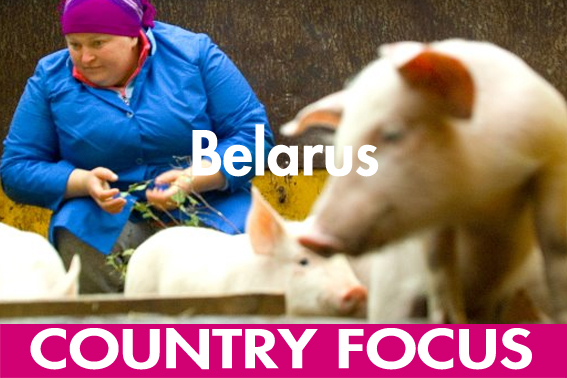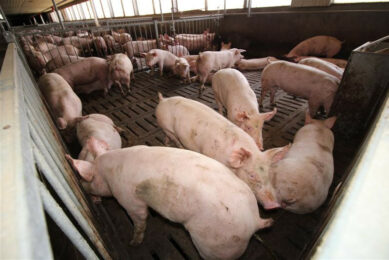Belarus: Is there life after the ASF epidemic?

In theory, the plans by the Belarusian government seem enormously ambitious – adding 1 million ?commercial pigs in barely two years’ time. In ?addition, the percentage of backyard farms needs to come down from 47% to 15%. What caused ?the transition?
At a first glance, African Swine Fever (ASF) seems to have bypassed Belarus. The country has only reported two outbreaks to the World Organization for Animal Health (OIE) – both in 2013. One in a village in Grodno province – in eastern Belarus, close to the border of both Lithuania and Poland, and the other on a commercial farm in Vitebsk province, in the north west.
Looking more closely, however, it appears that data must be missing. Given that neighbouring countries like Poland and the Baltic States have been intensively fighting with the virus in its wild boar population since the beginning of 2014, it is hard to believe that Belarus’ two reports tell the full story. It gets even more interesting when looking at overall pig inventory figures in Belarus: they dropped from 3.3 million heads in the middle of 2013 to 2.6 million heads in the middle of 2014, according to data from the National Statistic Committee of the Republic of Belarus. The figures point to a silent and uncontrollable killer: ASF.
A phenomenon that may soon be something of the past – sale of pigs at an agricultural fair in Belarus’ Gomel region. Photo Hanna Sarkisian | Dreamstime
The apparent lack of transparency has not made things easy for Belarus. Apart from most probably having infected wild boar herds in other Eastern European countries, the country’s trading position has deteriorated. Belarus cannot export pork to Russia, Ukraine and various other countries. In addition, absence of clear information is discouraging foreign investors, including trade partners, Russia and Ukraine.
Not surprisingly, pork imports did double in 2014 – from 20,000 tonnes per year in 2013 to 40,000 tonnes one year later, with the major amounts coming from Poland and Denmark.
Important part of agriculture
The outbreaks have affected one of Belarus’ most important parts of agriculture. Just like in neighbouring Ukraine, pig farming has historically been important. And that is likely to remain that way – the industry has the full support of the country’s president Alexandr Lukashenko, in charge since 1990. In 2014, the revival of the pig industry was put forward as the country’s strategic goal for 2015 with Lukashenko promising to spare no effort on this issue.
The government’s strategic plan provides that all the country’s pig farms, affected by ASF in the recent years, should be in full production again by the end of the year. At the same time, seven new pig farms, with a total annual production capacity of 170,000 head of finisher pigs will have been commissioned.
Detailed pig farming development programme
The detailed pig farming development programme was presented in early 2015 by staff of the Belarusian ministry of agriculture and food. In particular, the creation of two pig farms were announced, called Agrokombinat Zhdanovichi and Zabolotski – both in the centrally located Minsk region. These will have a total capacity of about 50,000 finishers per year.
In addition, 2015 will see the first stage of development of the large pig complex named Danprod, in the Volozhin district of the Minsk region, with an annual production capacity of 100,000 finishers. At the same time, pig farming will be started up again in 17 different farms and pig production units. These measures should allow Belarus to boost the total pig population to 3.7 million heads, which is 1 million more than mid-2014.
Backyard farming
In this process of transition, it is expected that Belarus will virtually move away from pork production in backyard farms. This type of farming has always been known as relatively low-profit, but since ASF has been around, backyard farming has even become a liability. The government therefore has recently criminalised ‘allowing the occurrence of ASF outbreaks’. Under this law, vets and farmers can be jailed for several years for allowing outbreaks to occur, hence it is expected that all new pig farms will have the highest level of biosecurity. The share of commercial farms could therefore make a jump from 53% (mid-2013) to almost 86% (late 2015).
Socially important industry
In Belarus, pork is a socially important commodity. In 2014, the price of pork rose by more than 60%. The price for 1 kg of pork went up from 100,000 Belarusian roubles (US$ 6.75) to 180,000 roubles ($ 12.1) by the end of the year. Considering that the country’s average annual income is about 6 million rouble ($ 405), this rise is indeed overwhelming.
ASF only partly explains this price rise. Official statistical data indicated that in 2014 the total volume of pork production dropped to 163,000 tonnes – a 22.9% year-on-year decrease. The most important reason was the devaluation of the Belarusian rouble, which only in December of 2014 dropped by 30% against both the dollar and euro.
Pushing prices even up further
This factor promises to push the prices up even further in the remainder of 2015, as Belarusian pork producers are depending on e.g. imported premixes, feed vitamins and minerals. To curb the price hikes, the Belarusian government has been trying to set maximum domestic market prices for pork – a development which might not favour the country’s pig industry.
It is clear that Belarusian pig farming today is going through the major challenges, just as a whole economy. The current season (May through October) will demonstrate if the government’s approach to tackle ASF has been successful. For all that may happen, new outbreaks might well ruin the government’s ambitious plans.
Belarus at a glance
Belarus has a surface of roughly 208,000 km2 – about the same size as Nebraska (USA), housing approximately 9.6 million inhabitants. The capital Minsk houses approximately 1.8 million; other major cities include Brest, Grodno, Gomel, Mogilev and Vitebsk. The country has been independent from the Soviet Union since 1991. Just like in neighbouring Ukraine, pork is the most popular type of meat, with both beef and mutton not being very popular. Traditionally, the country knows a variety of different kinds of pork sausages. Pig production occurs in all regions of the country, with Minsk region being the most important.











